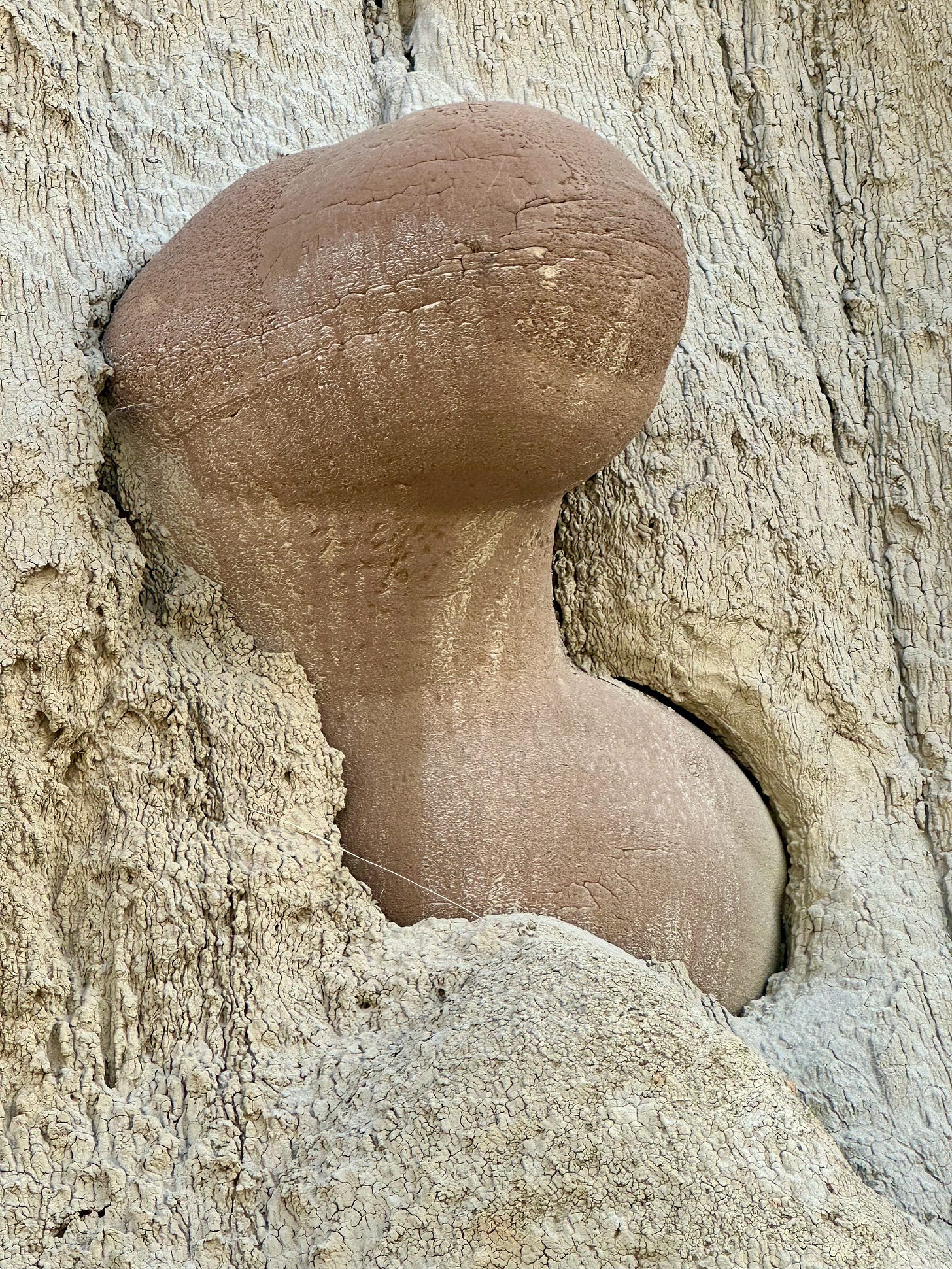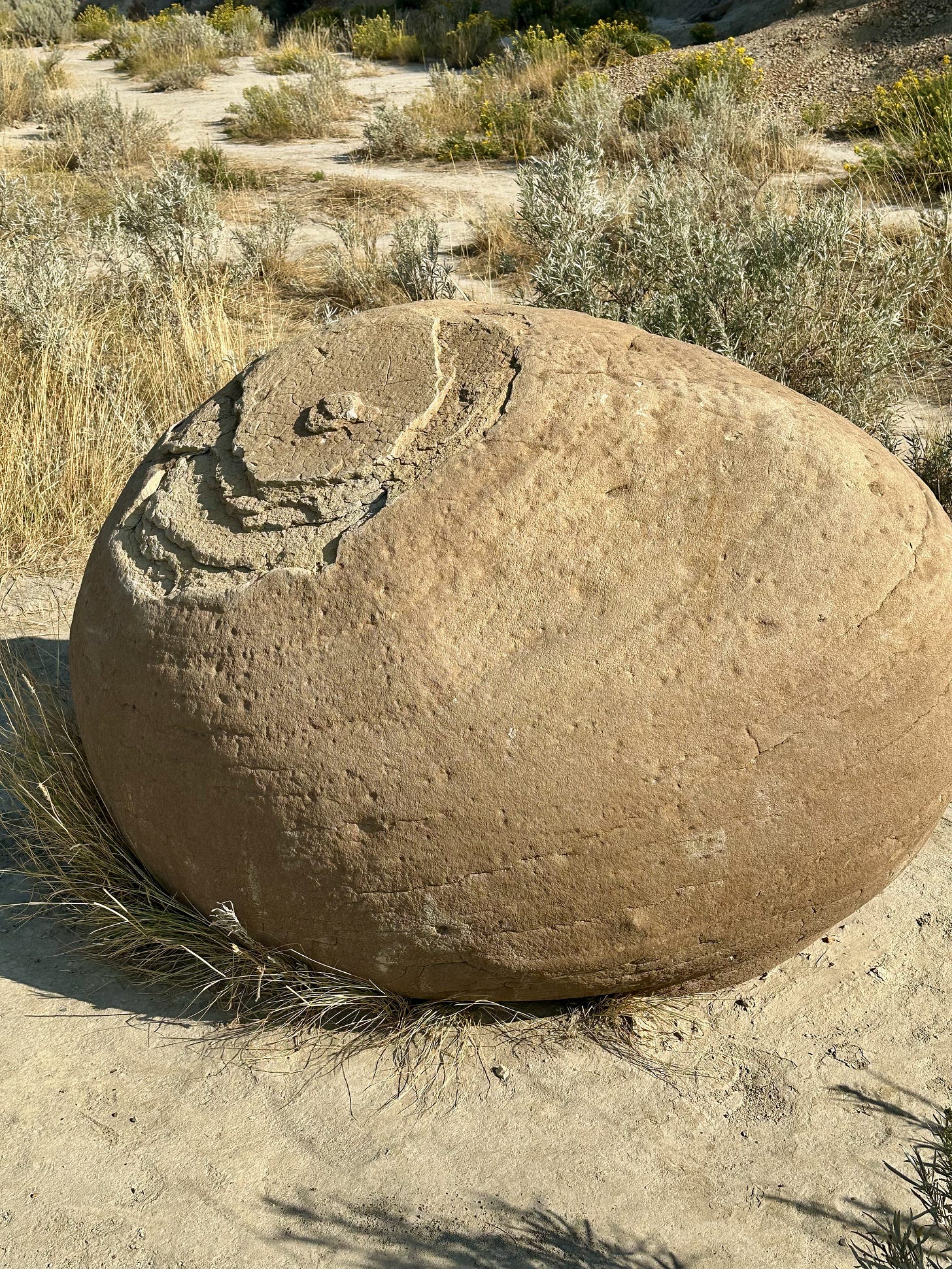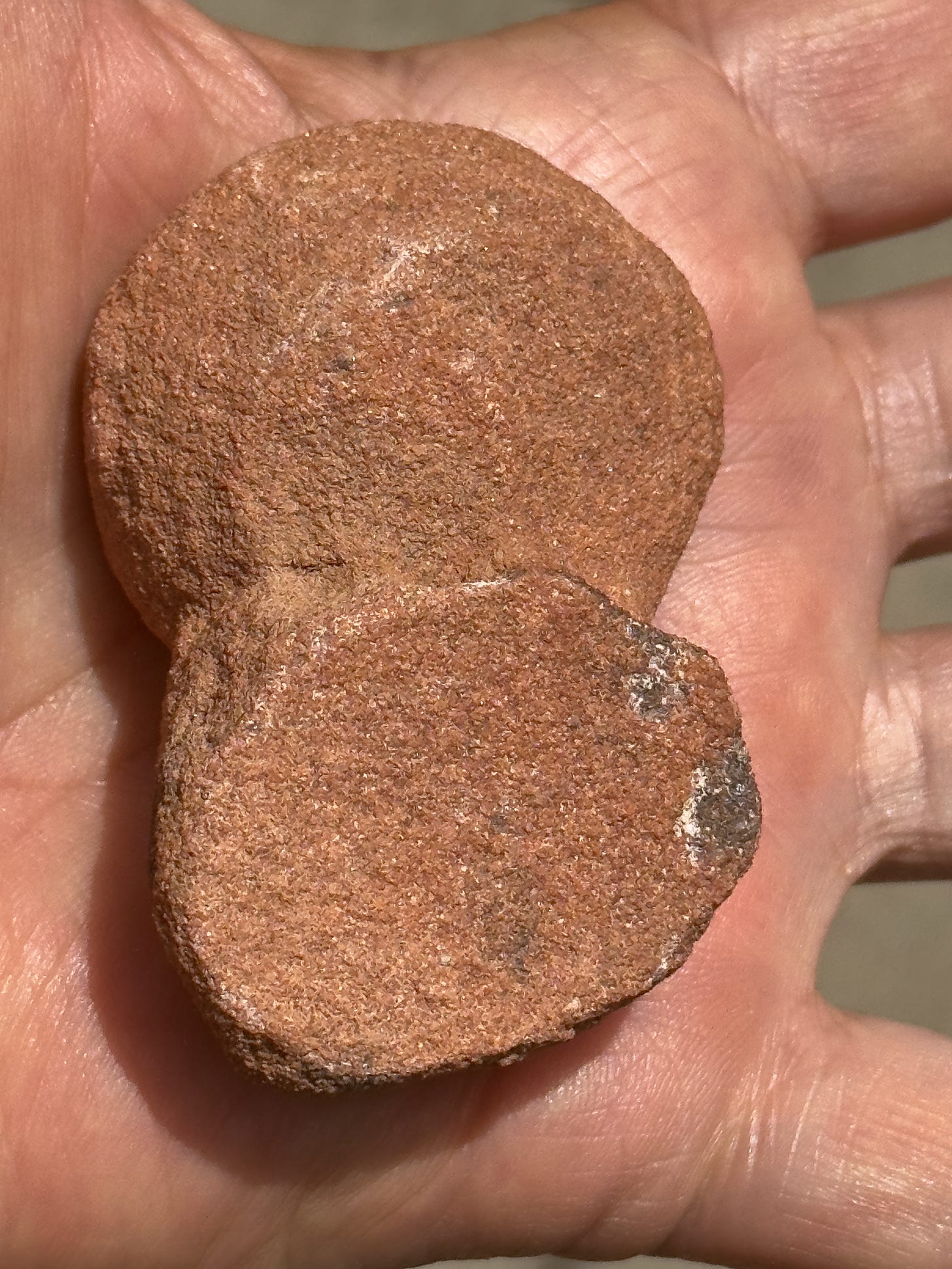Evidence of Predators Past?
I left Cottonwood Campground mid-morning and headed to the North Unit. Much of the hour plus drive was through the Little Missouri National Grassland, a mixed grass prairie. I saw a few pronghorns, all males. It was mating season, and the males seemed to be establishing dominance in preparation for wooing females. I never saw an actual full on locked horn contest, but I did witness the immediate aftermath at my first stop in the North Unit. The victor was chasing the vanquished with breath-taking speed. The chase was across a wide bottomland area, through a prairie dog colony, rifled with their burrows, a treacherous seeming landscape to be running through at such speed.
This was a sustained pursuit. The winner really wanted to drive the point home. When the one fleeing approached a gallery forest along the Little Missouri River, it was as if he was repelled. He veered severely to remain in open space. There is nothing less appealing to a pronghorn than a forest. I watched them run until they disappeared in the distance, gratified to have witnessed for my first time these wonderful creatures running at close to max speed.
Pronghorns are the fastest land animals in north America. They can achieve top speeds of 60 MPH, second only to the cheetah (61 MPH) among all mammals on earth. And pronghorns can maintain their top speed far longer than cheetahs. Even more impressive they can run for seemingly ever at 40 mph. That’s freakish endurance. True, they can’t jump at all; they’d have to run around wheelbarrow. But jumping isn’t required in the places they roam. Pronghorns occupy open landscapes. With their outstanding vision they can spot any potential predator from afar, hence the aversion to forests. They remain skittish in the presence of humans, no doubt because they are still hunted with rifles that kill from afar.
The tremendous speed and endurance of pronghorns seems excessive, given the nonhuman predators they could potentially fall prey to. It is downright mysterious from an evolutionary perspective. Most mammals are as fast as they need to be to either chase down their prey or to avoid becoming prey. But no existing pronghorn predator is remotely fast enough to chase down an adult pronghorn. And it’s only a matter of days until the newborn can outrun most predators. This has led some to propose that pronghorns evolved their remarkable speed to escape a predator that is now extinct. The favored candidate is the American cheetah, which roamed the continent during the Pleistocene, beginning about 2.5 million years ago. The last of the American cheetahs died around 16,000 years ago.
It seems reasonable that only a cheetah could cause, in an evolutionary sense, an animal to reach pronghorn speeds. But none of the prey species of African cheetahs are as fast as pronghorns. Moreover, contrary to what was previously believed, the American cheetah wasn’t all that closely related to the African cheetah. In fact, the American cougar was the closest relative if the American cheetah. Though long of limb like the African cheetah, the American cheetah was heavier and much less specialized for chases in wide open spaces. So the mystery of pronghorn speed and endurance remains.
Pronghorns are not your typical artiodactyl (two toed) ruminants (four chambered stomachs), which include sheep, goats, cattle, deer, and antelope. They are often confused with the latter in particular and are commonly referred to as pronghorn antelopes. But these are no antelopes. They are far more interesting and unique. pronghorns are the sole surviving species of an entire family (Antilocarpidae). Their closest relatives are giraffes (Giraffidae), with whom they share funky horns. But pronghorn horns and giraffe horns are funky in different ways. The funkiness of pronghorn horns is that the outer bony sheath is shed each year and regrown. More like deer antlers than antelope horns.
Concretions
Aside from the pronghorns, the other highlight of the day was geological. Strange rock forms protruding from the sedimentary rock layers. Concretions tend to be rounded but aside from that feature the variations are endless. Here is one that I nicknamed the “alien faceplant”.
It brought to my mind a hapless space invader, fallen from the mother ship, perhaps forcibly ejected for talking too much, its life ignominiously ended in a hard landing on earth.
Eventually the concretions are eroded out of the sediments completely and roll to the bottom of the hill, like this one, which was about three feet in diameter.
There were a couple of areas in the north unit where concretions were especially abundant, some still emplaced, most on the ground. I enjoyed exploring these somewhat surreal landscapes. The forms wore quite various, including a substantial phallic subset. Shaivite Hindus would find many worship worthy linga here.
In addition to their surface entertainment value, the concretions have an interesting and improbable genesis. How do you get these rust red solidified rocks out of white sediments. As is so often the case in geology it begins with impurities. In this case two kinds of impurities. The first impurity is a particle that is not like the other sand particles. Perhaps it is larger, or perhaps it is chemically out of the ordinary on its surface. This nonconforming sand particle is the seed for the concretion. The second impurity is chemical. Water circulating through the sediments through capillary action carries with it a variety of chemicals, the specifics depending on local environmental factors. In the North Dakota badlands the relevant chemical is iron, which precipitates around the seed.
Iron in water circulating through the sediment grains precipitates around the seed grain. Once initiated the process is feedforward, the more iron previously precipitated the more iron attracted to the concretion. As the concretion grows it makes space for itself by displacing surrounding sand grains.
The concretion is more resistant to erosion than the rest of the sedimentary material surrounding it. Therefore, when erosion reaches the layer in which the concretion resides it protrudes from the surrounding material on the slope face. Here is a photo taken a few days ago of smaller concretions on 180 million year old Aztec sandstone in Red Rocks Canyon National Preserve in Nevada.
(In this case, both the concretions and the rest of the sandstone are red due to iron oxidation. As in North Dakota, the concretions are erosion resistant relative to the background formation.)
Eventually the concretion tumbles to the ground, creating a wonderland of odd rocks that you would not associate with the surroundings if not for the fact that some are still protruding from the slope above. (Here is a small fallen concretion from Red Rock Canyon:)
Concretions represent a special type of sedimentary rocks. Most sedimentary rocks are composed of sediments, particles of various sizes that accumulate in basins, land or sea. (These basins often become high points over time, a process called topographic inversion)
Concretions, on the other hand have an entirely chemical genesis. Other chemical sedimentary rocks include travertine, opal and tufa. The agates formed in the lavas around Lake Superior, which I discussed in a previous post, are also, technically, chemical sedimentary rocks. Silica is the water born chemical responsible for agate concretions, and opal as well.
Incoming
The smoke had cleared noticeably because of a change in the winds. Those new winds were harbingers of an oncoming storm, which became increasingly noticeable as I toured the north unit. I reluctantly left the concretion area to return to my campground in the south unit in case things got sketchy. When I arrived at Cottonwood, I asked a ranger about the weather forecast. The news wasn’t good: severe storm warning, powerful thunderstorms likely, possibly tornados
I didn’t relish the opportunity to ride out the storm in my tent, so I decided to skedaddle. My plan was to head west across the border into eastern Montana and find myself a cheap room. Even a cursory glance of the atlas would have revealed the folly of that idea, as would a cursory examination of my own memory. For I had been in eastern Montana before and had experienced the utter absence of human settlements large enough to warrant a hotel. That had been a big part of its attraction for me in the past. Now, not so much. As I drove through the spectacular empty (of humans) landscape, the skies ever more ominous, an emergency broadcast came on the radio warning of immanent tornados in the area. What to do, what to do?







